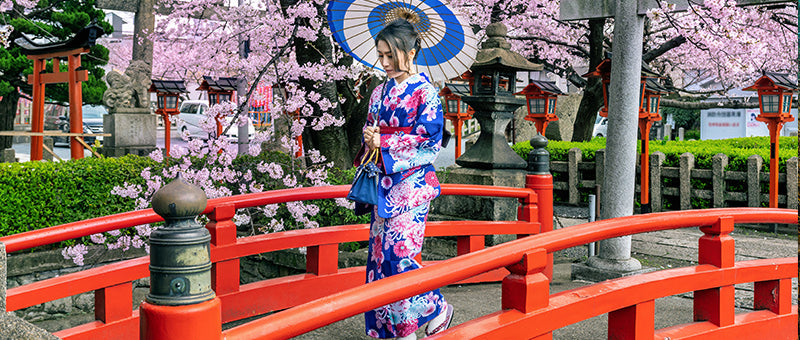
Visit Japan - The Best Season to travel
Japan is a land of striking contrasts, blending ancient traditions with modern innovation. This diverse and captivating country offers visitors a unique experience regardless of the season, but the best time to visit depends largely on what you want to see and do. Each season in Japan has its own charm, providing different opportunities and experiences. Let’s explore the highlights of each season to help you determine the best time for your visit.

Spring (March to May)
Spring is arguably the most popular season for tourists visiting Japan, primarily because of the iconic cherry blossom season. The sakura (cherry blossoms) bloom in late March to early April, transforming cities and countryside into a breathtaking sea of pink and white petals. Hanami (flower viewing) is a traditional Japanese custom where people gather under blooming cherry trees to have picnics, celebrate, and enjoy the beauty of the flowers.
Top Locations for Cherry Blossoms:
- Tokyo: Ueno Park, Shinjuku Gyoen, and Chidorigafuchi are famous spots for cherry blossom viewing.
- Kyoto: The Philosopher’s Path, Maruyama Park, and the grounds of Heian Shrine.
- Hokkaido: Goryokaku Fort Park in Hakodate and Matsumae Park.
Apart from cherry blossoms, spring is also a great time to visit Japan’s many gardens, which come alive with a variety of blooms. The weather is generally mild and pleasant, making it ideal for outdoor activities and sightseeing.
Spring Festivals:
- Hanami Festivals: Various locations host specific cherry blossom festivals with food stalls, performances, and illuminations.
- Takayama Spring Festival: One of Japan’s most beautiful festivals with intricate floats and vibrant parades.

Summer (June to August)
Summer in Japan is characterized by high temperatures and humidity, but it also brings a lively and festive atmosphere. The season kicks off with the rainy season (tsuyu) in June, but by mid-July, the weather becomes hot and humid.
Key Summer Attractions:
- Festivals: Summer is festival season in Japan, with events like Gion Matsuri in Kyoto, Nebuta Matsuri in Aomori, and the fireworks festivals in various cities.
- Beaches and Islands: Okinawa and the beaches of Shonan near Tokyo are popular destinations to escape the heat.
- Alpine Retreats: The Japanese Alps offer a cool respite with activities like hiking and exploring traditional mountain villages like Shirakawa-go.
Cultural Highlights:
- Obon Festival: A Buddhist event in mid-August where families honor their ancestors with traditional dances and lantern ceremonies.
- Tanabata (Star Festival): Celebrated on July 7, where people write wishes on colorful paper strips and hang them on bamboo branches.

Autumn (September to November)
Autumn is another favorite season for tourists due to the stunning fall foliage. The changing colors of the leaves, particularly the maples (momiji) and ginkgo trees, create a picturesque landscape that is perfect for photography and nature walks.
Top Spots for Autumn Leaves:
- Kyoto: Tofukuji Temple, Arashiyama, and Kiyomizu-dera.
- Nikko: Famous for its vibrant foliage and historic temples.
- Nara: Nara Park and the surrounding temples offer a serene autumn experience.
The weather in autumn is generally cool and comfortable, making it an excellent time for outdoor activities like hiking and exploring the countryside. The cultural richness of this season, combined with the natural beauty, provides a balanced and immersive experience.
Autumn Festivals:
- Koyo Viewing: Similar to hanami in spring, koyo is the tradition of enjoying the autumn leaves.
- Jidai Matsuri (Kyoto): A historical festival showcasing the different periods of Japanese history with elaborate costumes and parades.

Winter (December to February)
Winter in Japan offers a completely different experience, with a magical charm that is especially appealing to those who love snow and winter sports. The northern regions, such as Hokkaido and the Japanese Alps, receive heavy snowfall and are renowned for their excellent skiing and snowboarding facilities.
Winter Highlights:
- Ski Resorts: Niseko, Hakuba, and Nozawa Onsen are top destinations for winter sports enthusiasts.
- Snow Festivals: The Sapporo Snow Festival features impressive ice and snow sculptures that attract visitors from around the world.
- Onsen (Hot Springs): There’s nothing quite like soaking in an outdoor hot spring while surrounded by snow. The hot spring towns of Kusatsu, Hakone, and Beppu are popular choices.
Cultural and Festive Events:
- New Year (Shogatsu): A major holiday in Japan, where traditional rituals are performed, and families gather to celebrate. Visiting shrines for the first prayer of the year (hatsumode) is a common practice.
- Omisoka: The Japanese New Year’s Eve, marked by temple bells ringing 108 times to symbolize the cleansing of 108 earthly desires.

Have you decided yet?
Choosing the best season to visit Japan depends on your interests and what you hope to experience. Spring offers the beauty of cherry blossoms and mild weather; summer brings vibrant festivals and beach activities; autumn provides stunning foliage and comfortable temperatures; and winter offers excellent skiing and enchanting snow festivals. Each season presents unique opportunities to explore the cultural and natural wonders of Japan, making it a year-round destination worth visiting. Whether you’re a first-time visitor or a seasoned traveler, Japan’s seasonal diversity ensures that there’s always something new and exciting to discover.

